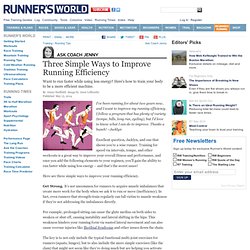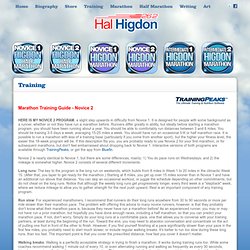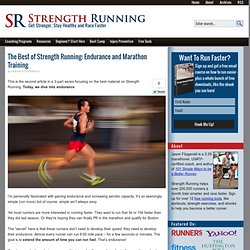

Four Strategies that Build Lasting Motivation (and How to Use Them to Achieve Your Goals) Get in shape (for real this time) 2 Minute Abs.
Jump In... to Cross-Training. Sometimes, it's what you do when you're not running that can give your training an edge.

That's the case with cross-training. A weekly nonrunning workout gives your muscles and joints a break from pounding the pavement while producing specific benefits that carry over to your running. "If you only run, you're essentially using the same muscles within the same plane of motion over and over again," says Shannon Colavecchio, CEO of Badass Fitness in Tallahassee, Florida, who trains runners in cycling, rowing, and core-strengthening classes. "Using different muscles and movement patterns can help you prevent injuries and also help you build speed and endurance. " Running Efficiently. Speed is for sprinters.NEW CW: Speed training helps everyone.

Think back on your past week of running. How much of it was at a brisk, saber-tooth–eluding clip? Today's top runners do as much as 20 percent of their training at speeds faster than race pace. This conditions the fast-twitch muscle fibers that are seldom recruited during slower running. It also maximizes aerobic capacity (the rate at which your muscles use oxygen) and increases stride power and efficiency. 8 Ways to Extend Your Long Run. Three Simple Ways to Improve Running Efficiency. I’ve been running for about two years now, and I want to improve my running efficiency.

I follow a program that has plenty of variety (tempo, hills, long run, cycling), but I’d love to know what I can do to improve. Thanks a bunch! ~Jacklyn Excellent question, Jacklyn, and one that shows you're a wise runner. Training for speed via intervals, tempo, and other workouts is a great way to improve your overall fitness and performance, and once you add the following elements to your regimen, you'll gain the ability to run faster while using less energy – and that’s the secret sauce!
Here are three simple ways to improve your running efficiency. Get Strong. For example, prolonged sitting can cause the glute medius on both sides to weaken or shut off, causing instability and lateral shifting in the hips. Planks (standard, mountain climbers, side plank raises)Squats (single and double leg)LungesClamsPush UpsRow with resistance tube or weightThe Bridge (with both feet on the ground or single leg) Hal Higdon Training Programs. Marathon Training Guide - Novice 2 HERE IS MY NOVICE 2 PROGRAM, a slight step upwards in difficulty from Novice 1.

It is designed for people with some background as a runner, whether or not they have run a marathon before. Runners differ greatly in ability, but ideally before starting a marathon program, you should have been running about a year. You should be able to comfortably run distances between 3 and 6 miles. You should be training 3-5 days a week, averaging 15-25 miles a week. Novice 2 is nearly identical to Novice 1, but there are some differences, mainly: 1) You do pace runs on Wednesdays, and 2) the mileage is somewhat higher.
Long runs: The key to the program is the long run on weekends, which builds from 8 miles in Week 1 to 20 miles in the climactic Week 15. Run slow: For experienced marathoners, I recommend that runners do their long runs anywhere from 30 to 90 seconds or more per mile slower than their marathon pace. Run Your Best Doubles. I thought running twice a day was hard enough—until I started training with coach Matt Centrowitz Sr. back in 2002.

Every Thursday, his group ran a tempo in the a.m. and a track or hill workout in the p.m. "Super doubles" helped us practice running fast on tired legs. The demands are severe, but if you can nail this session, you'll have the confidence of knowing that when the going gets tough, you can stay on pace. Build Your Base Centro started me off with easy 20-minute morning runs two or three times a week on quality days that gradually built to 40 minutes.
After six months, I got the green light for the tempo run. Run Tempo in the A.M. Hit Race Pace in the P.M. Add Doubles to 26.2 Training Another version of the double has marathoners combining two long sessions on a single day, building endurance without incurring the fatigue of a single long marathon-pace run—what Ryan Hall's new coach, Renato Canova, calls "special blocks. " 10 Boredom-Busting Treadmill Workouts: Workouts. The treadmill is the first place many people head when entering (or re-entering) a gym, says Andia Winslow, a personal trainer and sports performance coach at The Sports Center at Chelsea Piers in New York City.

"Too often, though, their mind is elsewhere — and speed, incline and overall intensity is far too low to affect major metabolic change," she says. This routine keeps you engaged in the workout while gradually increasing intensity — no texting while trotting here! How To Run A Half Marathon. Free Visual Workouts. Training for 50K and more. The Best of Strength Running: Endurance and Marathon Training. This is the second article in a 3-part series focusing on the best material on Strength Running.

Today, we dive into endurance. I’m personally fascinated with gaining endurance and increasing aerobic capacity. It’s so seemingly simple (run more) but of course, simple ain’t always easy. Yet most runners are more interested in running faster. They want to run that 5k or 10k faster than they did last season. The “secret” here is that these runners don’t need to develop their speed; they need to develop their endurance.